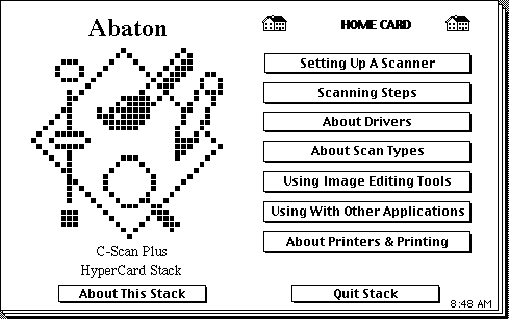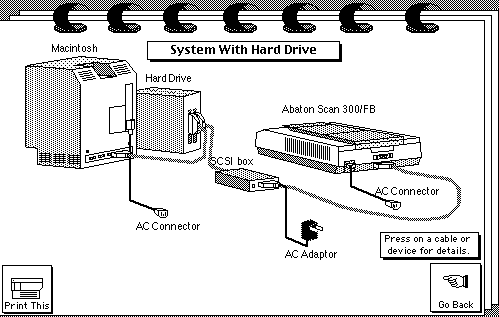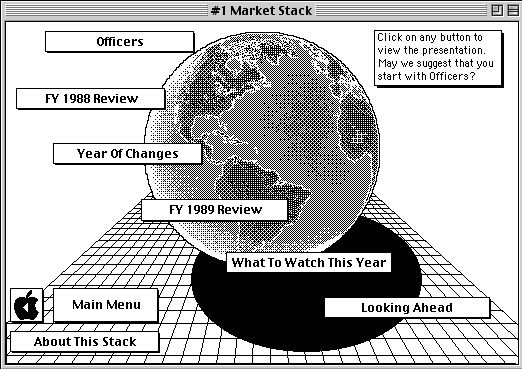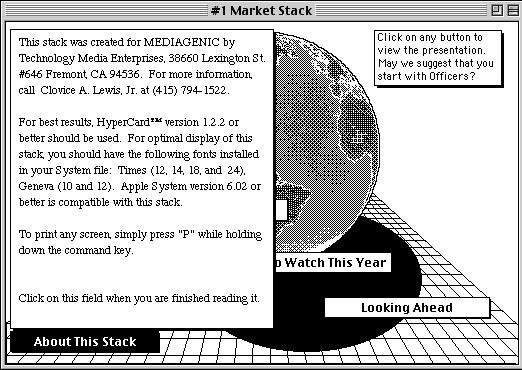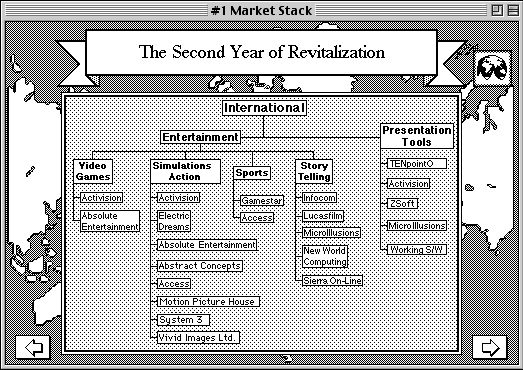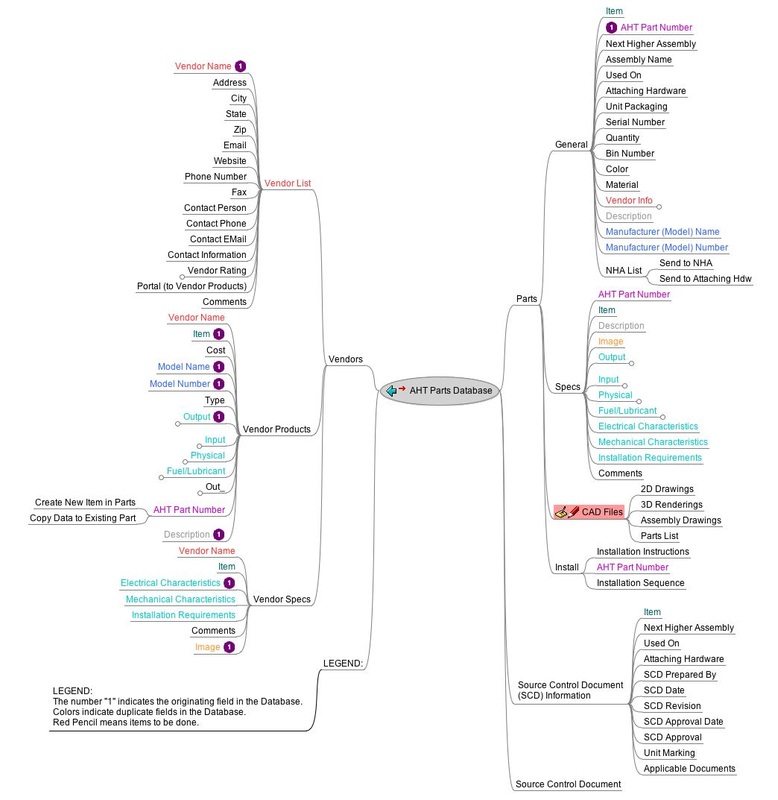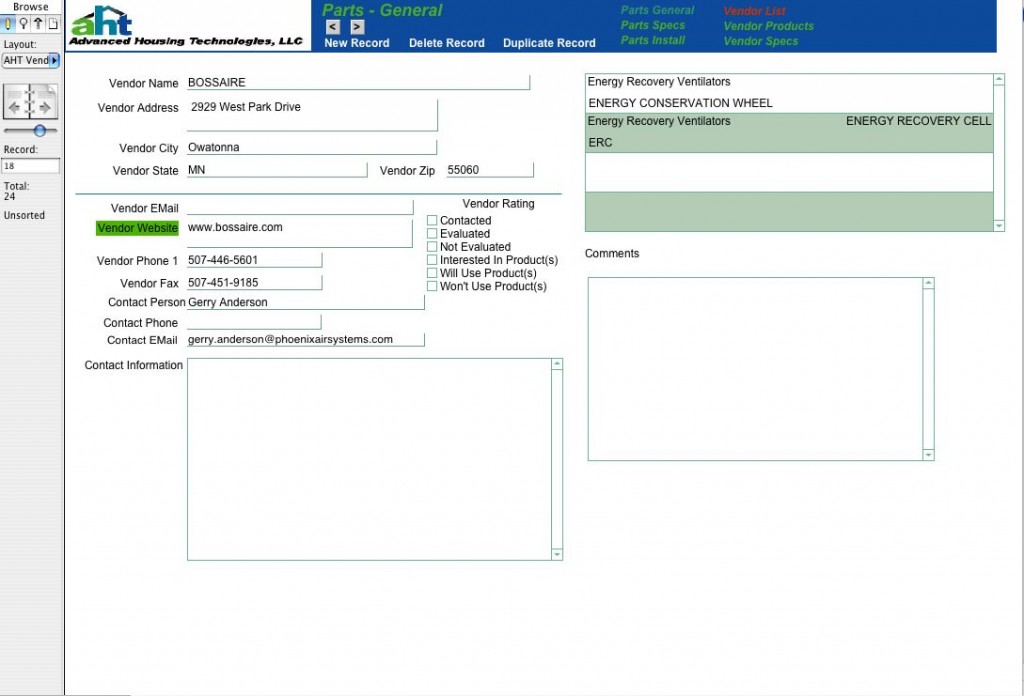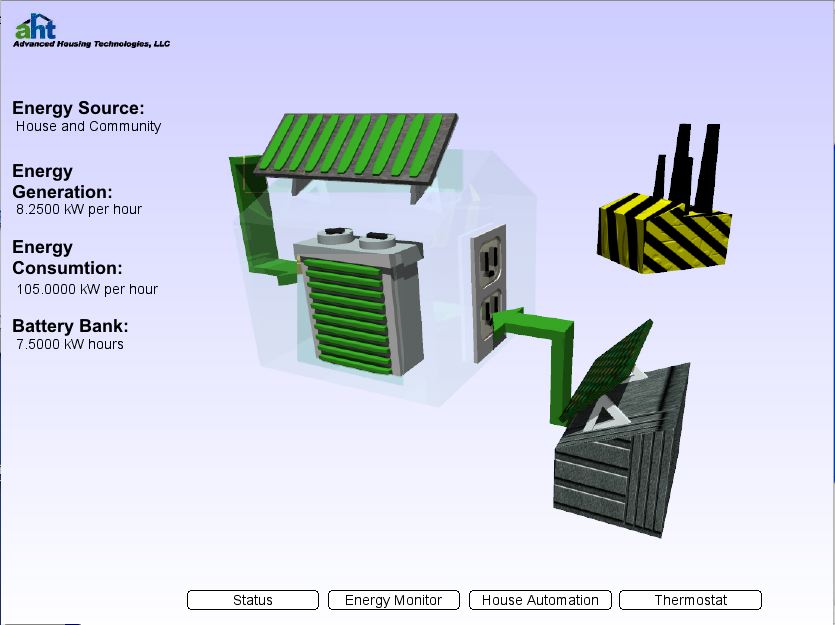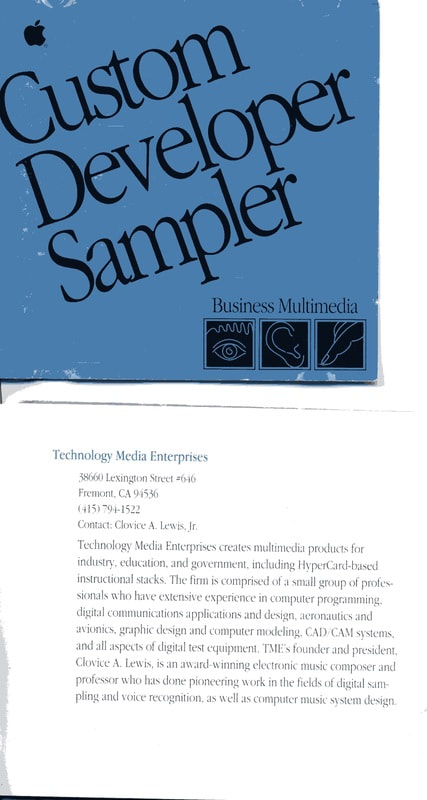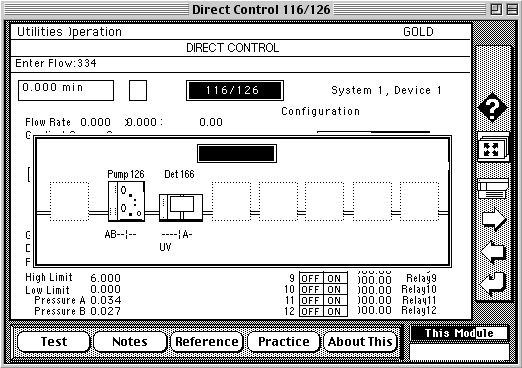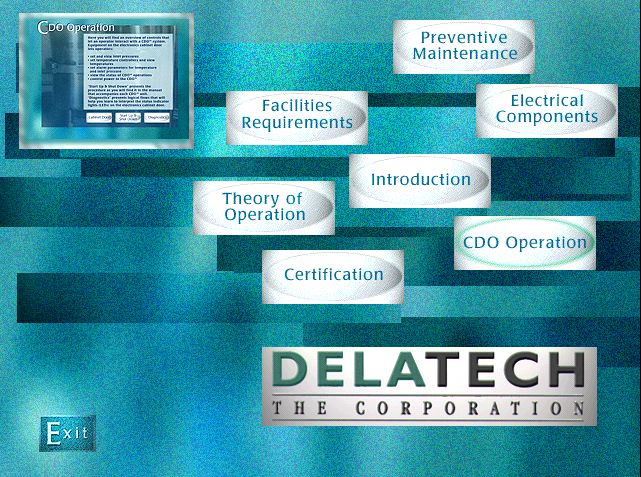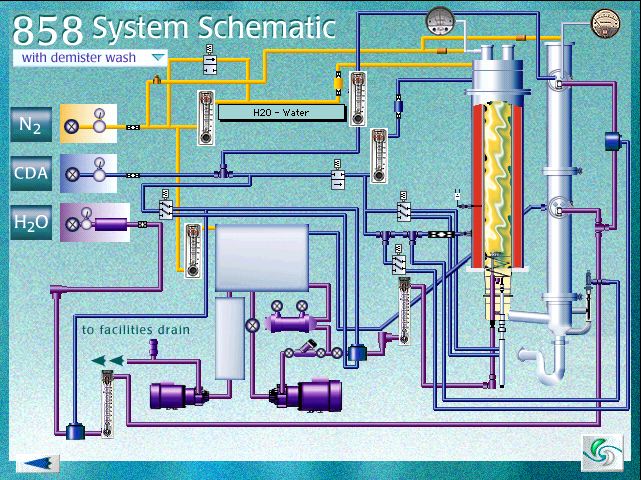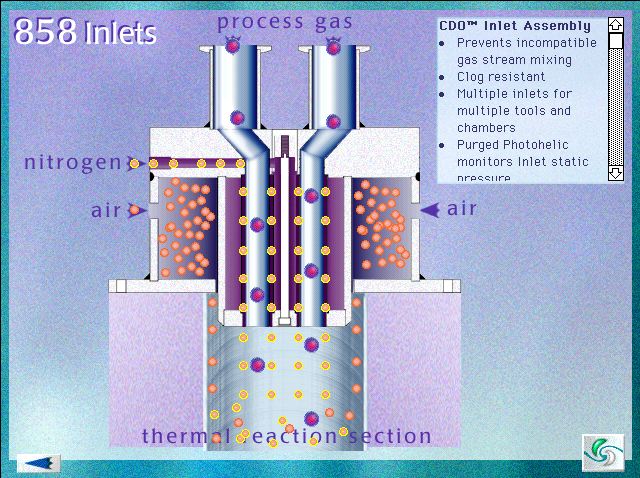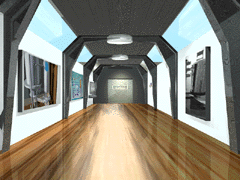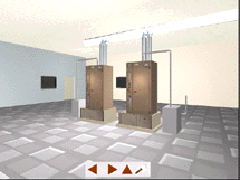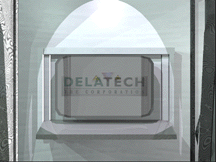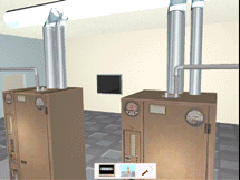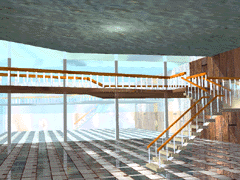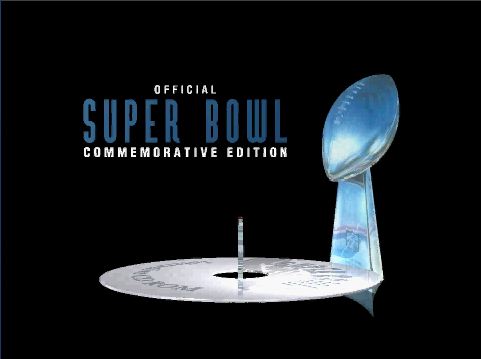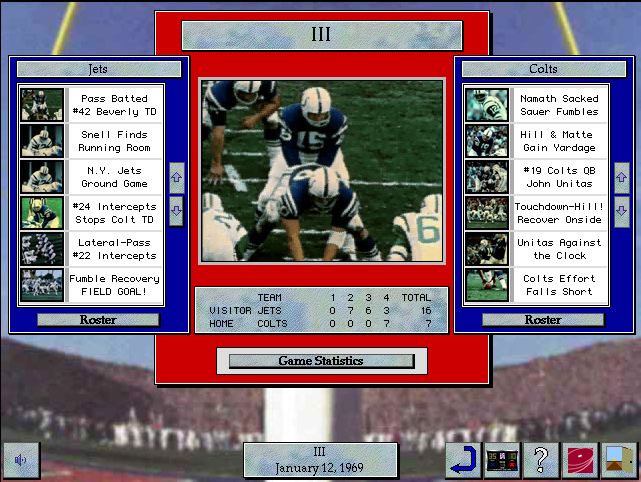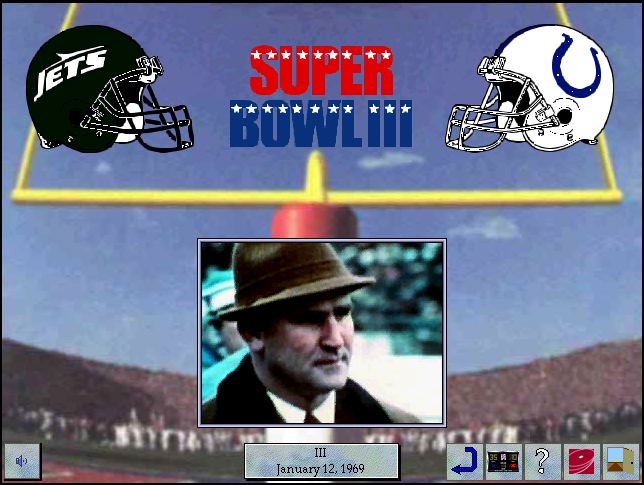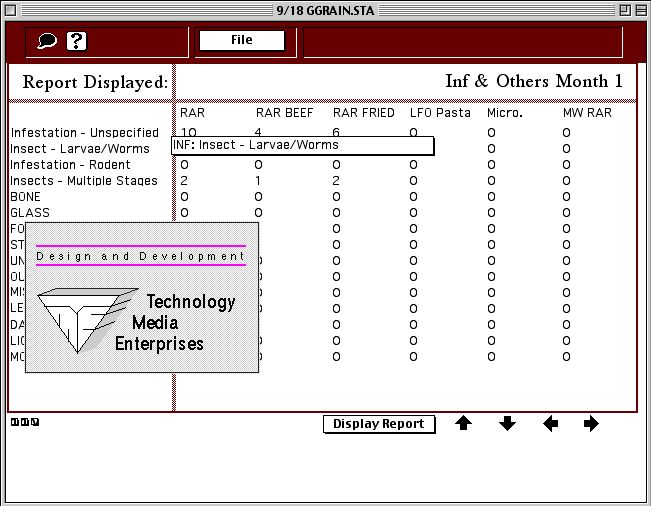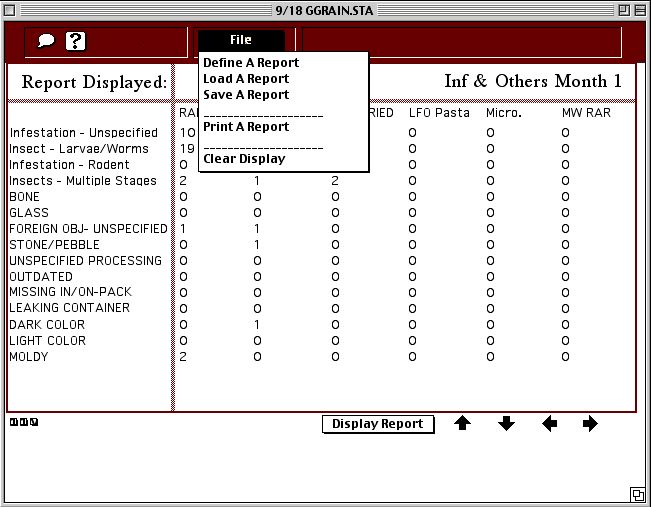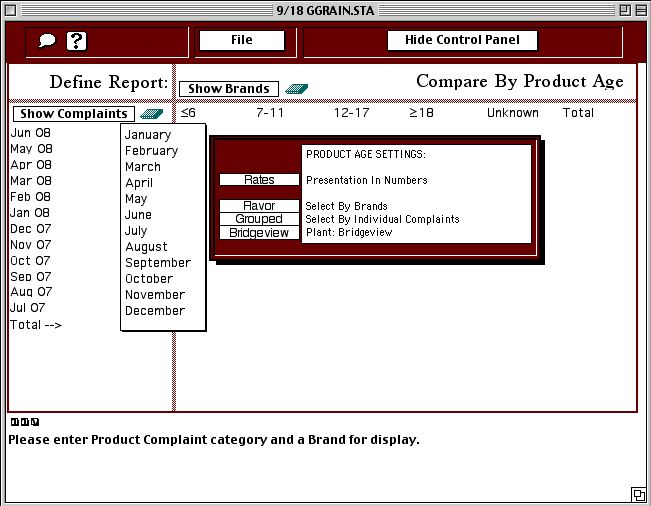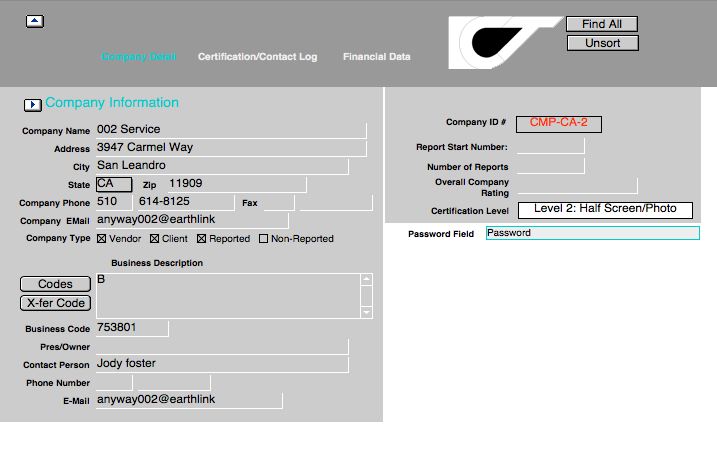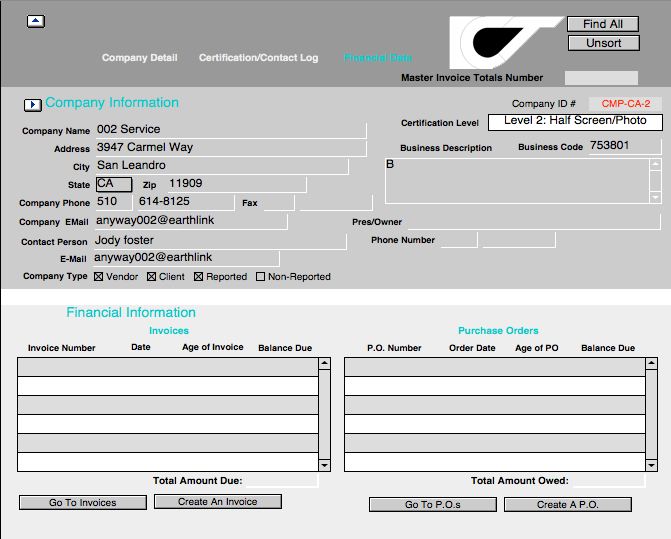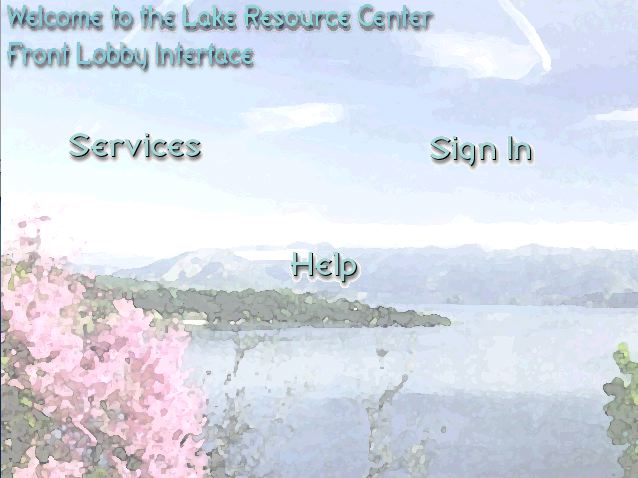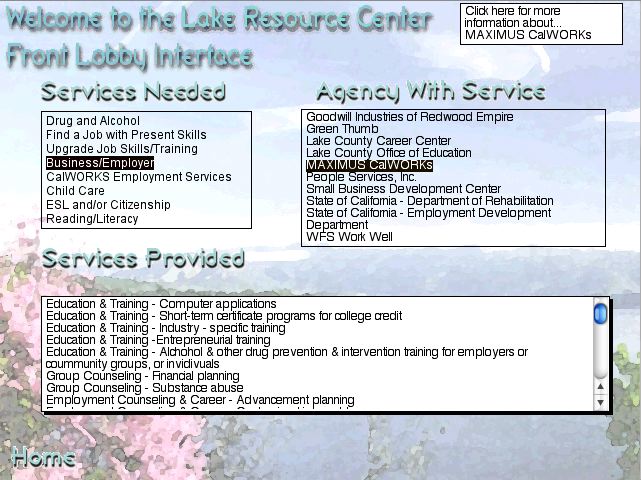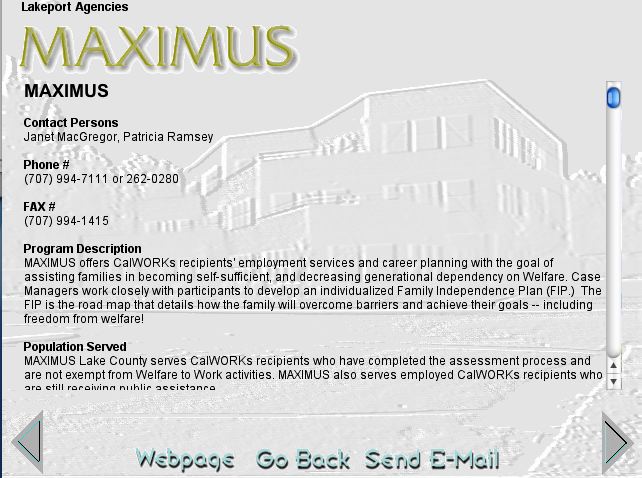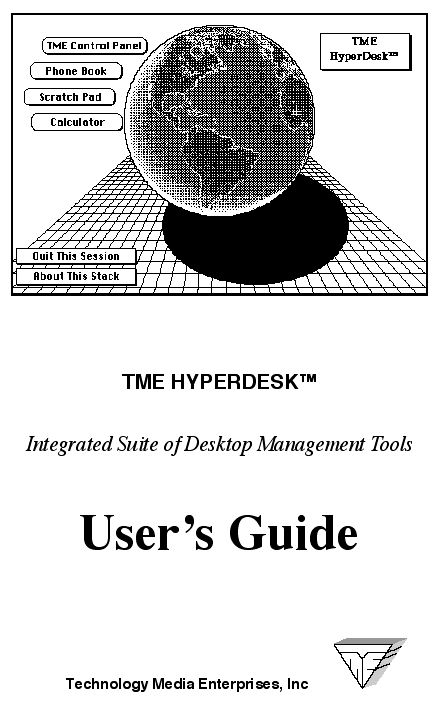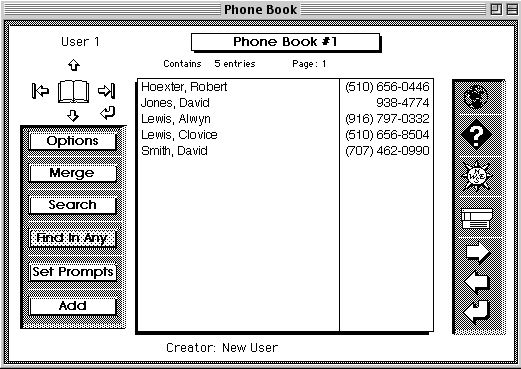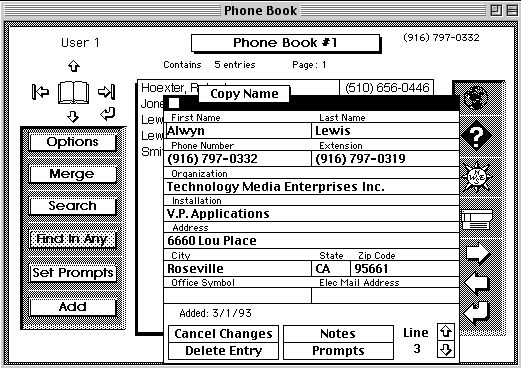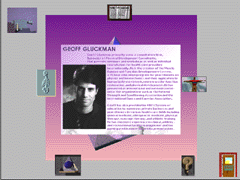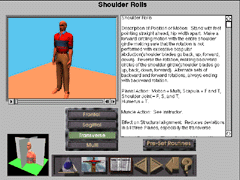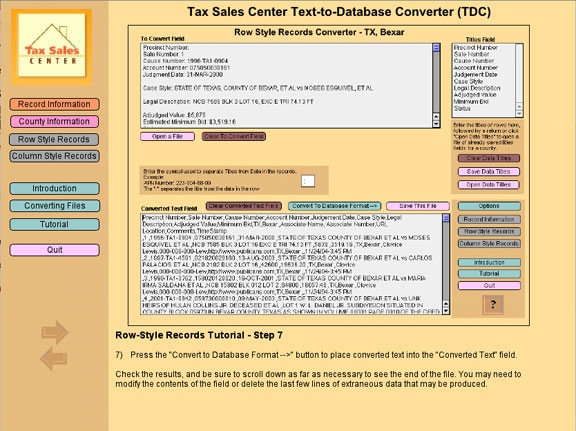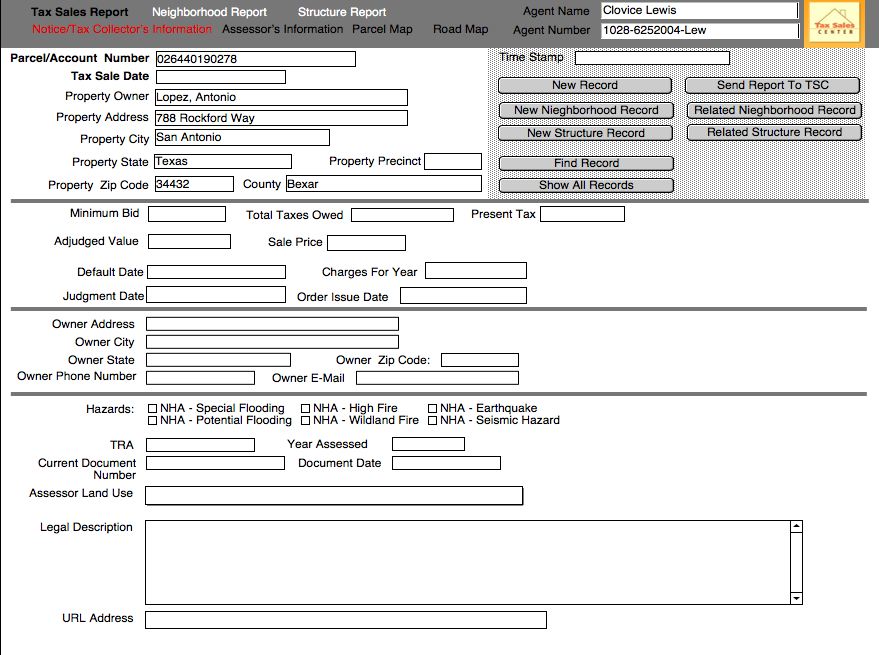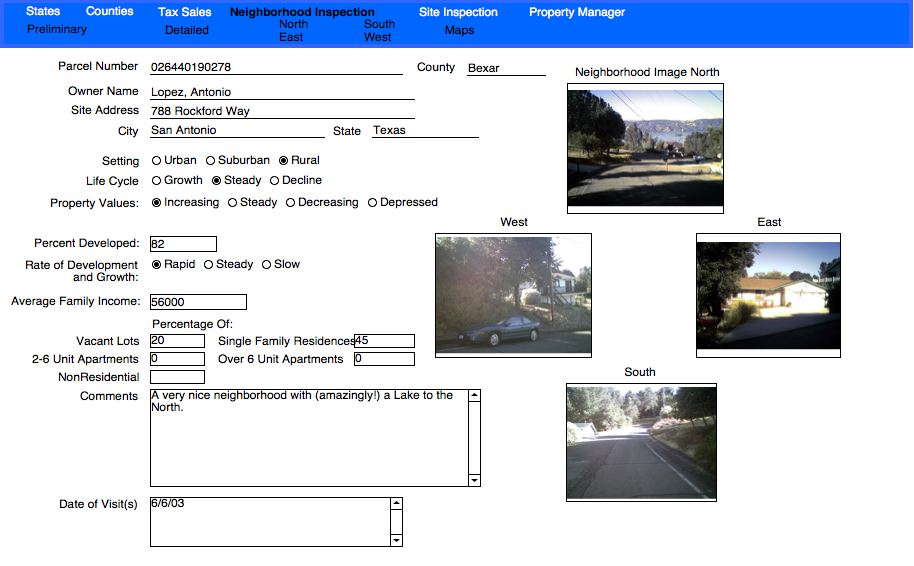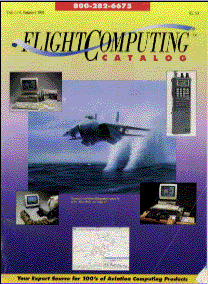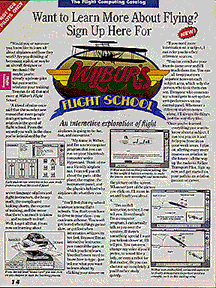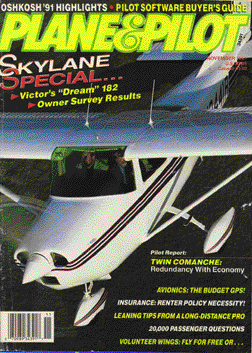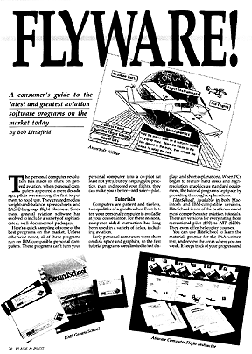CBT/Databases/Programming
This section describes my work in Computer Based Training, Database, and Software systems development since establishing Technology Media Enterprises (TME), my consulting firm, on March 16, 1984. I convinced some of the companies we did technical documentation for to also allow TME to create Computer Based Training for them. Our clients saw measurable improvements in overall training effectiveness as a result. For CBT, we first used HyperCard, switched to Spinnaker Plus, then settled on Macromedia Director after Lingo was incorporated.
For more “robust systems”, we used FileMaker Pro, C++, and other programming languages (although we rarely needed anything more than Director in most cases). Most of the work is personally done by me, but when required, I manage diverse teams of professionals devoted to providing the clients of TME, Consulting with the best CBT, Databases, and other system Software possible. These days, I am a great fan of LiveCode, which I believe to be the best OOP software development tool on the planet. Client companies are listed in alphabetical order.
For more “robust systems”, we used FileMaker Pro, C++, and other programming languages (although we rarely needed anything more than Director in most cases). Most of the work is personally done by me, but when required, I manage diverse teams of professionals devoted to providing the clients of TME, Consulting with the best CBT, Databases, and other system Software possible. These days, I am a great fan of LiveCode, which I believe to be the best OOP software development tool on the planet. Client companies are listed in alphabetical order.
Abaton
Abaton Corporation was a leading manufacturer of image scanners for computer systems during the early 1980s. Abaton produced a range of software and hardware to satisfy the need for digital imaging in the Apple Macintosh market of desktop publishing. I wrote the User’s Guides for Abaton’s C-Scan Plus and PanelScan.
In addition to writing and producing the User’s Guides for C-Scan Plus and PanelScan, I also created HyperCard stacks to be used with the programs. These represented the electronic industry’s first true “manual on a disk”, complete with interactive animations describing detailed operating features of the scanner software and hardware, “point-and-click” interface with the user, and dynamic random access to all information that is typically found in an operation and installation manual. This revolutionary documentation product, which was used by novice as well as experienced Macintosh computer operators, was considered a breakthrough in the field of product training and documentation.
Abaton Corporation was a leading manufacturer of image scanners for computer systems during the early 1980s. Abaton produced a range of software and hardware to satisfy the need for digital imaging in the Apple Macintosh market of desktop publishing. I wrote the User’s Guides for Abaton’s C-Scan Plus and PanelScan.
In addition to writing and producing the User’s Guides for C-Scan Plus and PanelScan, I also created HyperCard stacks to be used with the programs. These represented the electronic industry’s first true “manual on a disk”, complete with interactive animations describing detailed operating features of the scanner software and hardware, “point-and-click” interface with the user, and dynamic random access to all information that is typically found in an operation and installation manual. This revolutionary documentation product, which was used by novice as well as experienced Macintosh computer operators, was considered a breakthrough in the field of product training and documentation.
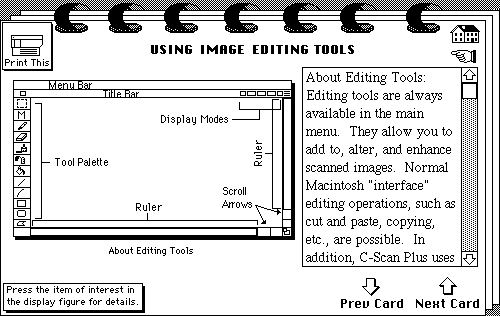
As can be seen here, the user was able to view detailed information about how to use the C-Scan Plus software by simply clicking anywhere on this screen. The system included animations and sound as well as text. It was reported that Abaton's use of this system cut back their service calls remarkably. In addition, users found the on-line documentation more convenient to use that the manual because of its emulation features.
Activision (Mediagenic)
Activision Inc. (ATVI) is a video game developer and publisher, founded on October 1, 1979 and was the first independent developer and distributor of video games for gaming consoles. Its first products were cartridges for the Atari 2600 video console system. Activision is now one of the largest third party video game publishers in the world and was also the top publisher for 2007 in the United States.
I created interactive HyperCard stacks for the yearly stockholder’s report for 1988.
Activision Inc. (ATVI) is a video game developer and publisher, founded on October 1, 1979 and was the first independent developer and distributor of video games for gaming consoles. Its first products were cartridges for the Atari 2600 video console system. Activision is now one of the largest third party video game publishers in the world and was also the top publisher for 2007 in the United States.
I created interactive HyperCard stacks for the yearly stockholder’s report for 1988.
Advanced Housing Technologies, LLC.
Advanced Housing Technologies LLC (AHT) provides a totally “green” solution for governments and companies requiring small temporary housing and associated utilities (energy, waste management, water and communications). Their products make it possible for communities to exist off the grid for an extended period of time.
I did extensive work as the lead designer for AHT Products. In that capacity, I created a sophisticated database that allows AHT to do research on products by potential vendors, bring the information about the products into their Engineering department for evaluation, and add the desired parts into their manufacturing inventory. This database fed into a larger Manufacturing Process Management (MPM) system.
Advanced Housing Technologies LLC (AHT) provides a totally “green” solution for governments and companies requiring small temporary housing and associated utilities (energy, waste management, water and communications). Their products make it possible for communities to exist off the grid for an extended period of time.
I did extensive work as the lead designer for AHT Products. In that capacity, I created a sophisticated database that allows AHT to do research on products by potential vendors, bring the information about the products into their Engineering department for evaluation, and add the desired parts into their manufacturing inventory. This database fed into a larger Manufacturing Process Management (MPM) system.
In addition to creating the databases for manufacturing, I also created the House Automation software that interfaces with Single Board Computers to control every aspect of energy and water consumption for the AHT emergency houses.
Apple, Inc.
Apple Inc. is an American multinational corporation which designs and manufactures consumer electronics and software products. The company’s best-known hardware products include Macintosh computers, the iPod and the iPhone.
My work with Apple has been extremely varied, and all unfortunately, buried deep inside software systems. I produced a series of software and documentation programs for apple Computers Training Division. These programs range from new product introductions material to specific computer-based vertical market training manuals. In addition to work with the Training Division, I created automated user profiles and documentation questionnaires for the Enterprise Publications group at Apple.
Click here for a pdf file of screen printouts of a HyperCard training program I created for the Apple Laser Printer in 1987.
Click here for a pdf file of screen printouts of a HyperCard sales presentation comparing Apple and IBM approaches to database development in 1988.
Apple Inc. is an American multinational corporation which designs and manufactures consumer electronics and software products. The company’s best-known hardware products include Macintosh computers, the iPod and the iPhone.
My work with Apple has been extremely varied, and all unfortunately, buried deep inside software systems. I produced a series of software and documentation programs for apple Computers Training Division. These programs range from new product introductions material to specific computer-based vertical market training manuals. In addition to work with the Training Division, I created automated user profiles and documentation questionnaires for the Enterprise Publications group at Apple.
Click here for a pdf file of screen printouts of a HyperCard training program I created for the Apple Laser Printer in 1987.
Click here for a pdf file of screen printouts of a HyperCard sales presentation comparing Apple and IBM approaches to database development in 1988.
Beckman Instruments (Beckman Coulter)
A leading designer, manufacturer, and marketer of laboratory instruments, Beckman Instruments, Inc., sells a broad range of diagnostic products and laboratory systems to customers who conduct basic scientific research, new product research, and diagnostic analysis of patient samples. With operations in more than 20 countries and more than half its sales generated outside the United States, Beckman ranks as global leader, able to keep ahead of its competition by making groundbreaking discoveries in the field of laboratory analytical systems.
In the early 1990’s, System Gold® HPLC systems incorporated the latest technological advances in hardware design. The solvent delivery modules are built with the digitally controlled rapid refill pump design with automatic compressibility compensation that has received multiple patents. These features produce smooth flow from microbore to semi-preparative flow rates, and the high-pressure mixing design eliminates the need for constant helium sparging or degassing. The pumps are combined with high-sensitivity UV/VIS and diode array detectors and autosamplers with automation capability to build HPLC systems that have a reputation for the best performance, ease of use and troubleshooting, and longevity due to a solid and reliable design.
I wrote technical manuals for the complete line of Beckman High Performance Liquid Chromatography (HPLC) known as “System Gold”. Included in the documentation was the Model 166 detector, Model 125 solvent delivery module, and the Noveau 125 166 HPLC. In addition to the Technical Manuals I created the HyperCard-based training and emulation stacks for the System Gold equipment.
Delatech, Inc. (now AMTI)
Delatech, Incorporated was founded in 1991 to provide environmental abatement equipment to the semiconductor industry. Based in Milpitas, California, it had approximately 110 employees and 1998 revenues in excess of $20 million. Major customers of Delatech products included Applied Materials, United Microelectronics Corp. (UMC), and Taiwan Semiconductor Manufacturing Corporation (TSMC). It was acquired by AMTI in 1999 for $50M.
In addition to writing technical manuals beginning in 1994, TME created cross-platform interactive corporate training CD-ROMs with built-in internet features for Delatech in 1997 and 1998. TME went further in 1998 to create a Virtual Lab that used a CD-ROM connected to the internet. The CD-ROM held all the animations and interactivity for the rich game-like interface. That, of course, was before most people had access to broadband internet speeds.
Delatech, Incorporated was founded in 1991 to provide environmental abatement equipment to the semiconductor industry. Based in Milpitas, California, it had approximately 110 employees and 1998 revenues in excess of $20 million. Major customers of Delatech products included Applied Materials, United Microelectronics Corp. (UMC), and Taiwan Semiconductor Manufacturing Corporation (TSMC). It was acquired by AMTI in 1999 for $50M.
In addition to writing technical manuals beginning in 1994, TME created cross-platform interactive corporate training CD-ROMs with built-in internet features for Delatech in 1997 and 1998. TME went further in 1998 to create a Virtual Lab that used a CD-ROM connected to the internet. The CD-ROM held all the animations and interactivity for the rich game-like interface. That, of course, was before most people had access to broadband internet speeds.
DiscUS Sports, Inc.
DiscUS Sports created the Official NFL Super Bowl Commemorative Edition, a three-disc set featuring video highlights of all 28 Super Bowls. The official NFL Super Bowl Commemorative Edition featured introductions by legendary sportscaster Pat Summerall, approximately three hours of live-action video and more than 1,000 still images from all 28 Super Bowls, starting with the first Super Bowl in 1966, through Dallas Cowboy Emmitt Smith’s heroics in 1994’s Super Bowl XXVIII. It was also the first Super Bowl CD-ROM title to be officially licensed by National Football League Properties Inc., New York.
I was hired by DiscUS as a consultant early in the project, in 1993, to create 3-D animations, do video editing, and create the prototype game using Macromedia Director.
DiscUS Sports created the Official NFL Super Bowl Commemorative Edition, a three-disc set featuring video highlights of all 28 Super Bowls. The official NFL Super Bowl Commemorative Edition featured introductions by legendary sportscaster Pat Summerall, approximately three hours of live-action video and more than 1,000 still images from all 28 Super Bowls, starting with the first Super Bowl in 1966, through Dallas Cowboy Emmitt Smith’s heroics in 1994’s Super Bowl XXVIII. It was also the first Super Bowl CD-ROM title to be officially licensed by National Football League Properties Inc., New York.
I was hired by DiscUS as a consultant early in the project, in 1993, to create 3-D animations, do video editing, and create the prototype game using Macromedia Director.
Golden Grain
The Golden Grain Macaroni Company is a Quaker Oats company that was acquired in 1986.
Golden Grain accumulated a huge mess of DB3 files and antiquated spreadsheets that they were hopelessly hobbled by, so by the time I caught up with them they saw the need to create a more sophisticated, modernized, and integrated documentation system. TME provided Golden Grain with a streamlined reporting system based on DB3 files, along with the User’s Manuals to operate the system.
The Golden Grain Macaroni Company is a Quaker Oats company that was acquired in 1986.
Golden Grain accumulated a huge mess of DB3 files and antiquated spreadsheets that they were hopelessly hobbled by, so by the time I caught up with them they saw the need to create a more sophisticated, modernized, and integrated documentation system. TME provided Golden Grain with a streamlined reporting system based on DB3 files, along with the User’s Manuals to operate the system.
Internet Certification Company
In 1999 ICC was poised to develop a unique system that allowed consumers to be an active, real-time part of the evaluation and certification process of any business, located anywhere. Consumers would be able to make complaints about, or praise, any company. Just a little ahead of its time, the company could not find funding. I created the Business Plan and financial projections for ICC. In addition to business development, I also helped to create the sophisticated on-line database that was the heart of the company.
In 1999 ICC was poised to develop a unique system that allowed consumers to be an active, real-time part of the evaluation and certification process of any business, located anywhere. Consumers would be able to make complaints about, or praise, any company. Just a little ahead of its time, the company could not find funding. I created the Business Plan and financial projections for ICC. In addition to business development, I also helped to create the sophisticated on-line database that was the heart of the company.
Lake Resource Center (Front Lobby Interface)
In 2001 I was hired by Maximus, Corporation to create a front lobby kiosk for the Lake County Resource Center, a one-stop center for human services in Lake County, CA.
In 2001 I was hired by Maximus, Corporation to create a front lobby kiosk for the Lake County Resource Center, a one-stop center for human services in Lake County, CA.
Lockheed Integrated Solutions Company
In 1990 the Department of Veterans Affairs chose Lockheed-Martin as the supplier of a new office automation system that was supposed to provide software, hardware, and services for database management and other services across a secure nationwide network. Lockheed performed under this contract between 1991 and 1997.
I led TME through a $10 million contract with Lockheed Integrated Solutions Company to provide the Veterans Administration with custom software for its office automation program known as NOAVA (Nationwide Office Automation for Veterans Affairs).
I had been developing “Wilbur’s Flight School” at the time, and realized the intuitive HyperCard-based system would be perfect for LISC’s needs. The VA wanted user tutorials for the myriad computer applications they would order from LISC, but did not want them printed or in videotape format.
I approached LISC management with a proposal to produce CBT tutorials using the TME “Explainer Series”. Click here to download the “Explainer Series” brochure. A subset of the CBT was the Installed Product Orientation applications, which provided an extremely cost-effective means of emulating the operation of other software. TME also demonstrated its ability to create desktop management tools (phone book, scratchpad, and more sophisticated calculator) for the VA. TME demonstrated our software solutions at the competitive 3-day Live Test Demo (LTD) the VA required to evaluate LISC’s solutions. TME passed with flying colors, impressing the NOAVA evaluation team with the elegance and sophistication of its products.
In 1990 the Department of Veterans Affairs chose Lockheed-Martin as the supplier of a new office automation system that was supposed to provide software, hardware, and services for database management and other services across a secure nationwide network. Lockheed performed under this contract between 1991 and 1997.
I led TME through a $10 million contract with Lockheed Integrated Solutions Company to provide the Veterans Administration with custom software for its office automation program known as NOAVA (Nationwide Office Automation for Veterans Affairs).
I had been developing “Wilbur’s Flight School” at the time, and realized the intuitive HyperCard-based system would be perfect for LISC’s needs. The VA wanted user tutorials for the myriad computer applications they would order from LISC, but did not want them printed or in videotape format.
I approached LISC management with a proposal to produce CBT tutorials using the TME “Explainer Series”. Click here to download the “Explainer Series” brochure. A subset of the CBT was the Installed Product Orientation applications, which provided an extremely cost-effective means of emulating the operation of other software. TME also demonstrated its ability to create desktop management tools (phone book, scratchpad, and more sophisticated calculator) for the VA. TME demonstrated our software solutions at the competitive 3-day Live Test Demo (LTD) the VA required to evaluate LISC’s solutions. TME passed with flying colors, impressing the NOAVA evaluation team with the elegance and sophistication of its products.
Muscle Balance and Function Development System
For MBF, I developed a ground-breaking interactive CD for training purposes in 1997. Geoff Gluckman, the creator of the Muscle Balance and Function Development System, needed a cost-effective, highly visual means of demonstrating the exercises he has developed. Instead of going the traditional route of using actors in expensive video shoots, I created a fully animated 3D modeled environment. Instead of actors, he was able to present the exact exercises desired using animated 3D figures. The results were spectacular.
For MBF, I developed a ground-breaking interactive CD for training purposes in 1997. Geoff Gluckman, the creator of the Muscle Balance and Function Development System, needed a cost-effective, highly visual means of demonstrating the exercises he has developed. Instead of going the traditional route of using actors in expensive video shoots, I created a fully animated 3D modeled environment. Instead of actors, he was able to present the exact exercises desired using animated 3D figures. The results were spectacular.
Tax Sales Center
The Tax Sales Center (TSC) was the first company to recognize the outstanding opportunity in the market for a business that marries powerful technologies of computerized expert systems, relational databases, and instant Internet communications.
We intended to provide our customers with:
• instant access to thousands of properties on the Internet updated daily for a small monthly subscription
• a way to minimize the risk of investing in Tax Sales with groups of other people all over the world
• a sophisticated database that allows customized searches of properties to our customer’s exact needs
• powerful ways of visualizing information about a property for tax sale in integrated formats
• automated evaluation and analysis tools
• help in purchasing tax sales properties every step of the way
• help with managing properties once they are purchased
• courses and other multimedia instructional material
As founder and CEO of the Tax Sales Center from 2004 – 2006, I conceived of the business and developed all aspects of it. I wrote the Business Plan, created the financial projections, wrote all the training materials, programmed the special web crawlers that converted tax sales information from multiple sources, and programmed the online databases.
The Tax Sales Center (TSC) was the first company to recognize the outstanding opportunity in the market for a business that marries powerful technologies of computerized expert systems, relational databases, and instant Internet communications.
We intended to provide our customers with:
• instant access to thousands of properties on the Internet updated daily for a small monthly subscription
• a way to minimize the risk of investing in Tax Sales with groups of other people all over the world
• a sophisticated database that allows customized searches of properties to our customer’s exact needs
• powerful ways of visualizing information about a property for tax sale in integrated formats
• automated evaluation and analysis tools
• help in purchasing tax sales properties every step of the way
• help with managing properties once they are purchased
• courses and other multimedia instructional material
As founder and CEO of the Tax Sales Center from 2004 – 2006, I conceived of the business and developed all aspects of it. I wrote the Business Plan, created the financial projections, wrote all the training materials, programmed the special web crawlers that converted tax sales information from multiple sources, and programmed the online databases.
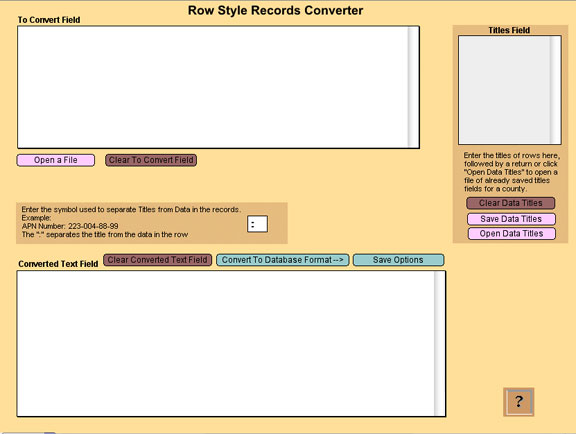
This is a part of a special Text-to-Data Converter I programmed to allow TSC database operators to populate the database using a wide variety of internet sources. I discovered most tax sales and foreclosure notices from counties are either organized by rows or columns. My Text-to-Data Converter allows the operator to configure the system for optimal data extraction, with minimal human intervention.
Teleglobe Communications, Inc. (Tata Communications)
in 1992 TME worked with Teleglobe to create a graphic user interface it created based on the Teleglobe Asynchronous Packet Assembler/Disassembler Supervisory Command Language. The original language required the user to remember up to 66 single line commands, each with up to as many as eight options. Although Teleglobe’s hardware was superior at the time, other companies attracted many of theirt potential clients by offering menu-driven software that was much easier to use — until the TME interface was adopted. The graphic front-end product from TME was then superior to the menu-driven designs of Teleglobe’s competitors
Wilbur’s Flight School
I created Wilbur’s Flight School© in 1990 as an interactive guide to aviation. I realized that the then, newly introduced HyperCard by Apple Computer, Incorporated could be used to produce an interactive encyclopedia. A multimedia format can breathe life into the many pages of boring technical information pilots are required to know. I was especially keen to produce Wilbur’s Flight School because I go my Private Pilot license in 1987 and would have appreciated the product as a study guide myself.
At that time AzureSoft®, a company which created its own aviation software and published a catalog called the Flight Computing Catalog®, was selling sophisticated flight simulators and other avionics for the general aviation community. t took only six months for me to create the world’s first truly interactive multimedia guide for aviation, which AzureSoft marketed as Wilbur’s Flight School©. Although it was originally created for Macintosh computers (in black and white), the November 1991 issue of Plane & Pilot magazine called it “…one of the best programs on the market…highly interactive and features excellent graphics and audio.”
Wilbur’s Flight School was a very simple, yet powerful example of effective multimedia design coupled with intelligent “hypertext” links to text. This combination created a rich environment for the study of virtually any subject.
in 1992 TME worked with Teleglobe to create a graphic user interface it created based on the Teleglobe Asynchronous Packet Assembler/Disassembler Supervisory Command Language. The original language required the user to remember up to 66 single line commands, each with up to as many as eight options. Although Teleglobe’s hardware was superior at the time, other companies attracted many of theirt potential clients by offering menu-driven software that was much easier to use — until the TME interface was adopted. The graphic front-end product from TME was then superior to the menu-driven designs of Teleglobe’s competitors
Wilbur’s Flight School
I created Wilbur’s Flight School© in 1990 as an interactive guide to aviation. I realized that the then, newly introduced HyperCard by Apple Computer, Incorporated could be used to produce an interactive encyclopedia. A multimedia format can breathe life into the many pages of boring technical information pilots are required to know. I was especially keen to produce Wilbur’s Flight School because I go my Private Pilot license in 1987 and would have appreciated the product as a study guide myself.
At that time AzureSoft®, a company which created its own aviation software and published a catalog called the Flight Computing Catalog®, was selling sophisticated flight simulators and other avionics for the general aviation community. t took only six months for me to create the world’s first truly interactive multimedia guide for aviation, which AzureSoft marketed as Wilbur’s Flight School©. Although it was originally created for Macintosh computers (in black and white), the November 1991 issue of Plane & Pilot magazine called it “…one of the best programs on the market…highly interactive and features excellent graphics and audio.”
Wilbur’s Flight School was a very simple, yet powerful example of effective multimedia design coupled with intelligent “hypertext” links to text. This combination created a rich environment for the study of virtually any subject.
